Zundt Corner alternatives
wallhanging: 39"x39"; personal throw: 50"x50"
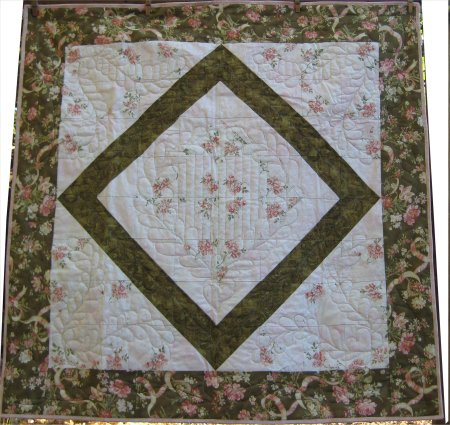



In 2005, I made a machine-embroidered quilt, which I called "Zundt Corners", after the company that digitized the embroideries. I taught Zundt Corners as a quilting class and included 2 alternative, non-embroidered versions as well, for those potential students who might like the layout but didn't have an embroidery machine or access to one. One alternative was a smaller, wall-hanging size and the other was a personal, throw size.
I never got around to finishing the alternative versions in 2005 and they have languished.
In August 2008, Mr. Pirate & I went on a 2 week road trip. It was the first time in 25 years that we didn't have ANY kids with us, we had the time and we could. So we did. :-) I like to have hand work to do on road trips because, quite frankly, simply being a passenger would drive me crazy and have Mr. Pirate searching for the passenger eject button. :-)
I decided that this layout deserved feathers. Yes, feathers .... one of the more difficult things to be done with a long-arm machine. Now, in my defense, I've done feathers on my home machine, so I am familiar with what SHOULD be done. But translating that to a long-arm machine is a little different. :-) Some of the feathers came out nicely. Some did not. Some sides came out much nicer than other sides and some spines look a whole lot better than others.
I also did some heart designs and daisy petals in various places and they came out mostly horrid. It is *really* difficult to get smooth curves on small-scale designs! Heck, it's difficult to get smooth curves on LARGE scale designs! I did rip out the most horrid of them and re-did them on my home machine, since I have much more experience, control and confidence on it. But I was lazy and didn't rip out all of them ...
1) if I had wanted to do a really GOOD job, I could have done the entire thing on my home machine
2) this was the state of my (lack of) skill on my longarm at this point in time.
So, it's a good historical artifact. [sounds like a good story, doesn't it?] [update: I since found out that templates are the way to get wonderful looking shapes.]
But ... it was a learning experience that tells me I need to do longarm quilting a LOT more. :-)
In any case, I did
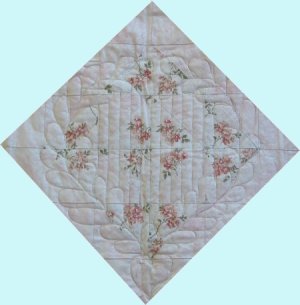 | big feathered heart in the center medallion. I also learned how to use a straight edge with my long-arm to get nice *straight* lines. The heart at the base really turned out lopsided. |
 | Lines of feathers are done in the green diamond band. These generally came out OK. I put daisy petals in the corners to anchor the feathers, but mostly because I couldn't figure out how to get the feathers to turn the corner! The daisy petals came out ... well .. yucky. You're not going to see a picture of them. :-) |
 | Feathered lyres are in the pink corners. The hearts at the base of the lyres were mostly OK. :-) |
 | Feathered arcs are in the green print border. I put hearts in the corners of the quilt and in the middle of the border to break up the feathered arcs. Once again, those hearts came out weird. |
So, with the quilting done prior to the trip, I used part of my road trip to hand sew the binding in place. When I returned home, I sewed on the casing for hanging the quilt on the back, as well as the label.
I didn't have enough time before our trip to do any more longarm quilting ... and as I was apprehensive about running *out* of handwork to do on the trip, I decided, in another bout of bold fearlessness, to hand-quilt this one. Now, I am NOT a hand quilter. I've done a couple of baby quilts before so I know that if I can't do the perfect 10-stitches-to-the-inch at least I can be consistent with the stitches I do make.
Because my daughters like very drapeable quilts from the git-go, I decided to back this top with a creamy white fleece, which would serve as both batting and backing.
To stabilize everything before I began the detailed quilting, I did a hand-done stitch-in-the-ditch along all straight edged seams and a large basting stitch around the perimeter.
The detailed hand-quilting was:
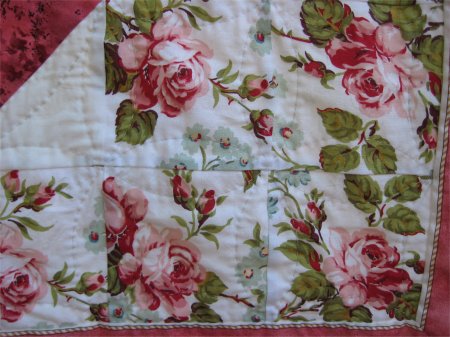 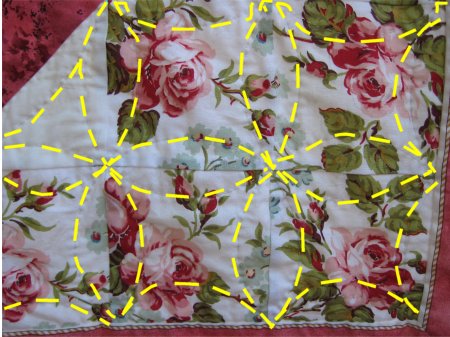 | Because some of the quilting would be in a large scale floral print and would essentially be lost, I elected to do a very basic orange peel quilting design in those areas. The quilting thread is an off-white. |
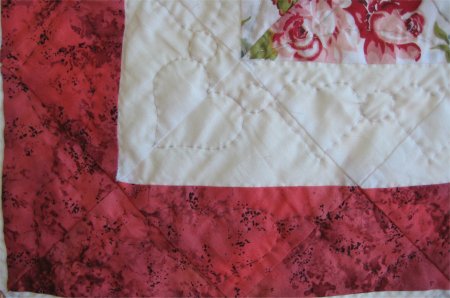 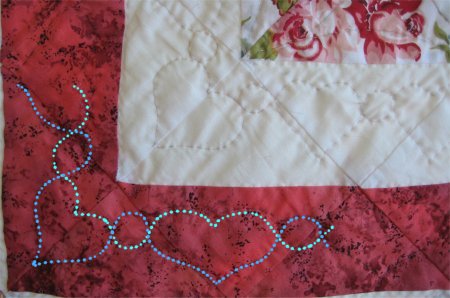 | In the white band and pink band areas, a heart and circle design was done . The quilting thread was a very pale pink in the white band and a dark green in the pink band. I was pleased how the quilting showed up in the white band but the dark quilting thread got lost in the dark speckles of the pink band; I should have used the off-white thread. |
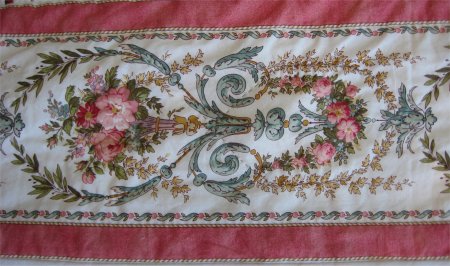 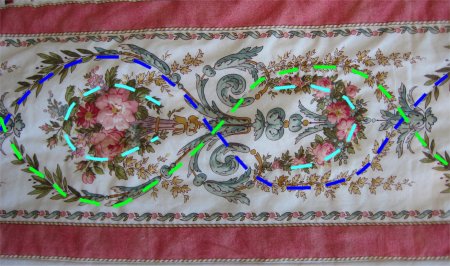 | The floral stripe border posed a problem. How the heck was this to be quilted??? Nothing intricate, as it wouldn't show up. I didn't want to do diagonal lines or cross-hatching. What I came up with was a double serpentine wave that followed the main design element of the fabric pattern. Inside the waves, I followed the semi-circular line of that fabric pattern. The quilting was done in dark green thread. You absolutely can not see any of this quilting on the front, which is actually what I wanted. |
I must say that, although the Quilt Police may turn up their collective noses at my hand-quilting, I am pleased with it. The stitches are even and consistent. They may not be teeny-tiny but they aren't toe-snaggers either.
Once they are washed ... to get rid of my pencil design lines and cat fur ... they will be given to our youngest daughter, Rene. It turned out that the colors in the quilts, which were chosen 3 years prior to them being finished, are exactly the colors of the living room in her new, first apartment. There is an accent wall in a medium moss green, she has a Victorian-looking sofa in pale cream/pink and a rose pink slipper chair in upholstery velvet. These quilts will coordinate very nicely with her furniture and will look simply perfect in Rene's living room, draped over her supine form, as she languishes on her sofa with perfect Victorian ennui. :-)